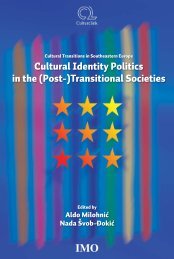D:\Documents and Settings\Ana\My Documents\Biserka-knjiga ...
D:\Documents and Settings\Ana\My Documents\Biserka-knjiga ...
D:\Documents and Settings\Ana\My Documents\Biserka-knjiga ...
You also want an ePaper? Increase the reach of your titles
YUMPU automatically turns print PDFs into web optimized ePapers that Google loves.
Digital Culture: The Changing Dynamics<br />
models which generate revenues. There are also “hybrid” versions of portals,<br />
covering elements of both.<br />
A very important element of a Web portal is the ability to connect individuals <strong>and</strong><br />
communities globally <strong>and</strong> to enable them to share <strong>and</strong> communicate in groups (small<br />
or extremely large) based on their interests. Nowadays a number of factors should be<br />
considered for a Web portal to be a successful social networking tool <strong>and</strong> to<br />
eventually earn money:<br />
• real-time collaboration services: instant messaging, discussions online, group<br />
calendars, shared online encyclopaedias;<br />
• integrated applications: workflow integration, syndicated content, group<br />
emails, common online workflow;<br />
• personalized delivery of content: providing information specific to needs <strong>and</strong><br />
preferences of a user, filtering based on priorities;<br />
• e-commerce possibilities.<br />
The term “user-generated content” was first used in 2005, reflecting the various<br />
kinds of media content produced by users, uploaded online <strong>and</strong> publicly available<br />
(such as blogging, podcasting, videos, etc.). In 2006 the global media announced the<br />
new Web world as a tool to make each person on the planet matter <strong>and</strong> giving him/her<br />
possibility to contribute, to promote, to be visible worldwide. The Web 2.0 tools<br />
(discussion groups, blogs, wikis, social networking sites, podcasts) started to become<br />
more <strong>and</strong> more popular <strong>and</strong> spread across the globe. They form an online<br />
environment created by users’ interactions <strong>and</strong> the content is published, changed,<br />
managed <strong>and</strong> used by everyone who wants to be part of the network. It is an intangible<br />
user-orientated structure.<br />
The emphasis in Web 2.0 tools is on the end user who has the power to speak out, to<br />
promote <strong>and</strong> develop his/her own br<strong>and</strong> with much less initial capital than was<br />
needed before. Creators <strong>and</strong> developers of websites realized that they could make<br />
money by increasing the users’ traffic <strong>and</strong> attracting advertising. This can happen of<br />
course only if content is very interesting for large numbers of users, or if the online<br />
platform is set up in an easy-to-share way. Artists, musicians, writers <strong>and</strong><br />
photographers today have a low-cost publishing mechanism to distribute their<br />
creative works. They can choose among numerous portals for posting their music,<br />
photos, books <strong>and</strong> other creative products. Producers also watch online<br />
self-promotion websites: record companies actually monitor the number of friends<br />
that a MySpace b<strong>and</strong> has <strong>and</strong> often sign up musicians when they reach a certain<br />
number of friends.<br />
168



